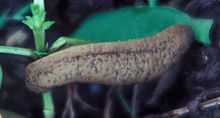Sarasinula plebeia
| Sarasinula plebeia | |
|---|---|
 | |
| A live individual of Sarasinula plebeia | |
| Scientific classification | |
| Kingdom: | Animalia |
| Phylum: | Mollusca |
| Class: | Gastropoda |
| (unranked): | clade Heterobranchia clade Euthyneura |
| Superfamily: | Veronicelloidea |
| Family: | Veronicellidae |
| Genus: | Sarasinula |
| Species: | S. plebeia |
| Binomial name | |
| Sarasinula plebeia (P. Fischer, 1868)[1] | |
| Synonyms[2] [3] | |
| |
Sarasinula plebeia, commonly called the bean slug or the Caribbean leatherleaf slug, is a species of air-breathing land slug, a terrestrial pulmonate gastropod mollusk in the family Veronicellidae, the leatherleaf slugs.
As of November 2012, some websites and databases (including the ITIS entry) have a species listed as "Sarasomia plebeia" by the same author.
Distribution
Sarasinula plebeia was originally discovered and described under name Vaginulus plebeius by French zoologist Paul Henri Fischer from New Caledonia in 1868.[1] The type locality is New Caledonia.[1]
The distribution of Sarasinula plebeia includes:
- Cuba[4]
- Jamaica[5]
- Saint Martin, Leeward Islands[6]
- Dominica[5]
- Canouan[5]
- Saba Island[6]
- southern USA[5]
- from Mexico[2] to Panama:[5]
- Rio Grande do Sul,[9] Brazil
- Venezuela[10]
It was also introduced to Australasia and some Pacific island groups:[5]
- Saipan,[6] Mariana Islands
- Ritidian Point,[6] Guam
- San José, Leyte, Philippines[6]
- Wasi, Ambon Island, Moluccas[6]
- Vate, Aoba Island, Malakula Island, Espiritu Santo and Malo Island, New Hebrides[11]
This species is already established in the USA, and is considered to represent a potentially serious threat as a pest, an invasive species which could negatively affect agriculture, natural ecosystems, human health or commerce. Therefore it has been suggested that this species be given top national quarantine significance in the USA.[12]
Ecology
Parasites of Sarasinula plebeia include:
As a pest
In Central America, this species is a serious pest of agriculture.[5]
Genetics
Although the species is economically important, only partial sequences of 28S ribosomal RNA gene of Sarasinula plebeia were published by Dayrat et al. (2001)[14] up to April 2010.
References
This article incorporates CC-BY-3.0 text from the reference.[5]
- ↑ 1.0 1.1 1.2 Fischer, P. (1868). Crosse, H.; Fischer, P., eds. "Diagnoses de deux Limaciens de la Nouvelle Calédonie". Journal de Conchyliologie (in French) (Paris) 16: 145–146. ISSN 0021-7719. Retrieved 23 November 2012.
- ↑ 2.0 2.1 Naranjo-Garcia E., Thome J. W. & Castillejo J. (2007). "A review of the Veronicellidae from Mexico. (Gastropoda: Soleolifera). Revision de los Veronicellidae de Mexico (Gastropoda: Soleolifera)". Revista Mexicana de Biodiversidad 78: 41–50.
- ↑ Terrestrial Mollusc Tool: Sarasinula
- ↑ Maceira D. F. (2003). "Las especies de la familia Veronicellidae (Mollusca, Soleolifera) en Cuba". Revista de Biología Tropical 51(3): 453-461. PDF.
- ↑ 5.0 5.1 5.2 5.3 5.4 5.5 5.6 5.7 Robinson D. G., Hovestadt A., Fields A. & Breure A. S. H. (July 2009). "The land Mollusca of Dominica (Lesser Antilles), with notes on some enigmatic or rare species". Zoologische Mededelingen 83 http://www.zoologischemededelingen.nl/83/nr03/a13
- ↑ 6.0 6.1 6.2 6.3 6.4 6.5 Forcart L. (1973). "Notes on Veronicellidae and Athoracophoridae in Field Museum of Natural History, Chicago". The Nautilus 87(1): 25-27.
- ↑ Naranjo-García E., Thomé J. W. & Castillejo J. (2007). "A review of the Veronicellidae from Mexico (Gastropoda: Soleolifera). Revisión de los Veronicellidae de México (Gastropoda: Soleolifera)". Revista Mexicana de Biodiversidad 78: 41-50."
- ↑ (Spanish) Barrientos Z. (2003). "Lista de especies de moluscos terrestres (Archaeogastropoda, Mesogastropoda, Archaeopulmonata, Stylommatophora, Soleolifera) informadas para Costa Rica". Rev. Biol. Trop. 51(Suppl. 3): 293-304. PDF
- ↑ Agudo-Padrón A. I. (14 May 2009). "Recent Terrestrial and Freshwater Molluscs of Rio Grande do Sul State, RS, Southern Brazil Region: A Comprehensive Synthesis and Check List". Visaya April 2009: 1-13. PDF.
- ↑ Fernández de V, J. 1992: Contribución al conocimiento de las babosas y sietecueros (Mollusca: Gastropoda) Revista de la Facultad de Agronomía Maracay. 12(3-4):374-387.
- ↑ Forcart L. (1969). "Veronicellid land slugs from the New Hebrides from the New hebrides, with description of Semperula solemi, new species". Fieldiana 51(12): 147-156.
- ↑ Cowie R. H., Dillon R. T., Robinson D. G. & Smith J. W. (2009). "Alien non-marine snails and slugs of priority quarantine importance in the United States: A preliminary risk assessment". American Malacological Bulletin 27: 113-132. PDF.
- ↑ http://web.archive.org/web/20071214020100/http://homepage.sunrise.ch/mysunrise/choegger/Slugs/Antagonists.html
- ↑ Dayrat, B.; Tillier, A.; Lecointre, G.; Tillier, S. (2001). "New Clades of Euthyneuran Gastropods (Mollusca) from 28S rRNA Sequences". Molecular Phylogenetics and Evolution 19 (2): 225–235. doi:10.1006/mpev.2001.0926. PMID 11341805.
Further reading
- Thomé J. W. (1975). "Os gêneros da familia Veronicellidae nas Américas (Mollusca; Gastropoda)". Iheringia Zoologia 48: 3-56.
- Rueda, A. A.; Slansky, F.; Wheeler, G. S. (1991). "Compensatory feeding response of the slug Sarasinula plebeia to dietary dilution". Oecologia 88 (2): 181. doi:10.1007/BF00320809.
- Rueda A., Caballero R., Kaminsky R. & Andrews K. L. (2002) "Vaginulidae in Central America, with emphasis on the bean slug Sarasinula plebeia (Fischer)". In: Barker G. M. (ed.). Molluscs as crop pests. CABI Publishing.
External links
- Sarasinula plebeia at National Center for Biotechnology Information (NCBI)
- Sarasinula plebeia on the UF / IFAS Featured Creatures Web site